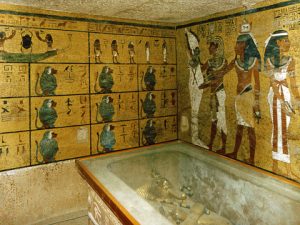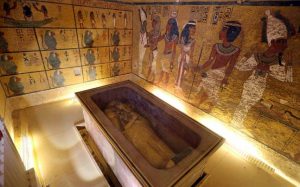
Pharaoh Tutankhamun was probably the son of the heretic pharaoh Amenhotep IV (better known in the history as Akhenaton, founder of one of the first monotheistic religions in human history). Tutankhamun ascended the throne when he was only nine in 1333 BC and died during the ninth year of his reign in 1224 B.C. Most probably he has been assassinated for unknown reasons. His tomb KV 62 was discovered in 1922 by the famous British Egyptologist Howard Carter. Carter's discovery of Tutankhamun's tomb was sensational at that time because, it is the most complete and intact Egyptian tomb ever found. The treasures that were found in the tomb of the boy king Tutankhamun amazed the whole world for years. You can notice this upon the faces of the tourists in the Egyptian museum when they see the golden mask of Tutankhamun. Tutankhamun died unexpectedly, so he was buried in haste. This can be seen in the lack of wall decoration in all rooms except the impressive burial chamber. The tomb is the smallest of the royal tombs in the Valley of the Kings, but is also the most famous. The treasures from the tomb can be seen in Cairo Egyptian Museum in a newly-renovated exhibition hall and are well worth a visit.
- Discovery of The Tomb of Tutankhamun

On 4, November, 1922, the tomb was discovered by Howard Carter who worked with Lord Carnarvon, a wealthy Englishman who was an archaeology enthusiast and he was the one who funded the expedition of Carter. "At first I could see nothing, the hot air escaping from the chamber causing the candle flame to nicker, but presently, as my eyes grew accustomed to the light, details of the room within emerged slowly from the mist, strange animals, statues, and gold everywhere, the glint of gold", Howard Carter said. The entrance staircase to KV 62 was discovered by the workmen on 4 November 1922, and the next day they exposed the now-famous sixteen steps that led down to a tomb entrance closed with mud and stone. Carter waited for Carvarnon's arrival before breaking through the doorway on 24 November. It took ten years of work to photograph, record, remove, and conserve the more than 3000 objects. The treasures of Tutankhamun are now displayed in the Egyptian Museum in Cairo, and visitors coming to the Valley of the Kings often expect the tomb to be equally extraordinary.
- The Architectutre of the Tomb of Tutankhamun

The Tomb of Tutankhamun had an unusual plan different from any other royal tomb. It consists of four small chambers covering only 110 square meters. Only the Burial Chamber walls were decorated, unlike royal tombs in which nearly all walls were painted with scenes from various books. At the bottom of the sixteen steps of the tomb lies an entrance corridor. When Carter entered the corridor, it was filled with rubble, though it had been penetrated by grave robbers at least twice.
After the first doorway, a descending corridor leads to the second sealed door, and into the Antechamber. The Antechamber measures 7.9 meters by 3.6 meters and its height is about 2.8 meters. The priests had crammed inside the tomb huge beds, war chariots, chairs, stools, painted boxes, alabaster jars, mummified ducks, and gilded statues. Tomb KV 62 includes some annexes that can be reached through a small-low door at the left side of the rear wall of the Antechamber. This room contained foods and unguents, jars of oils, bottles of wine, baskets of fruits and vegetables, and there were also pieces of jewelry, clothing, and furniture.
